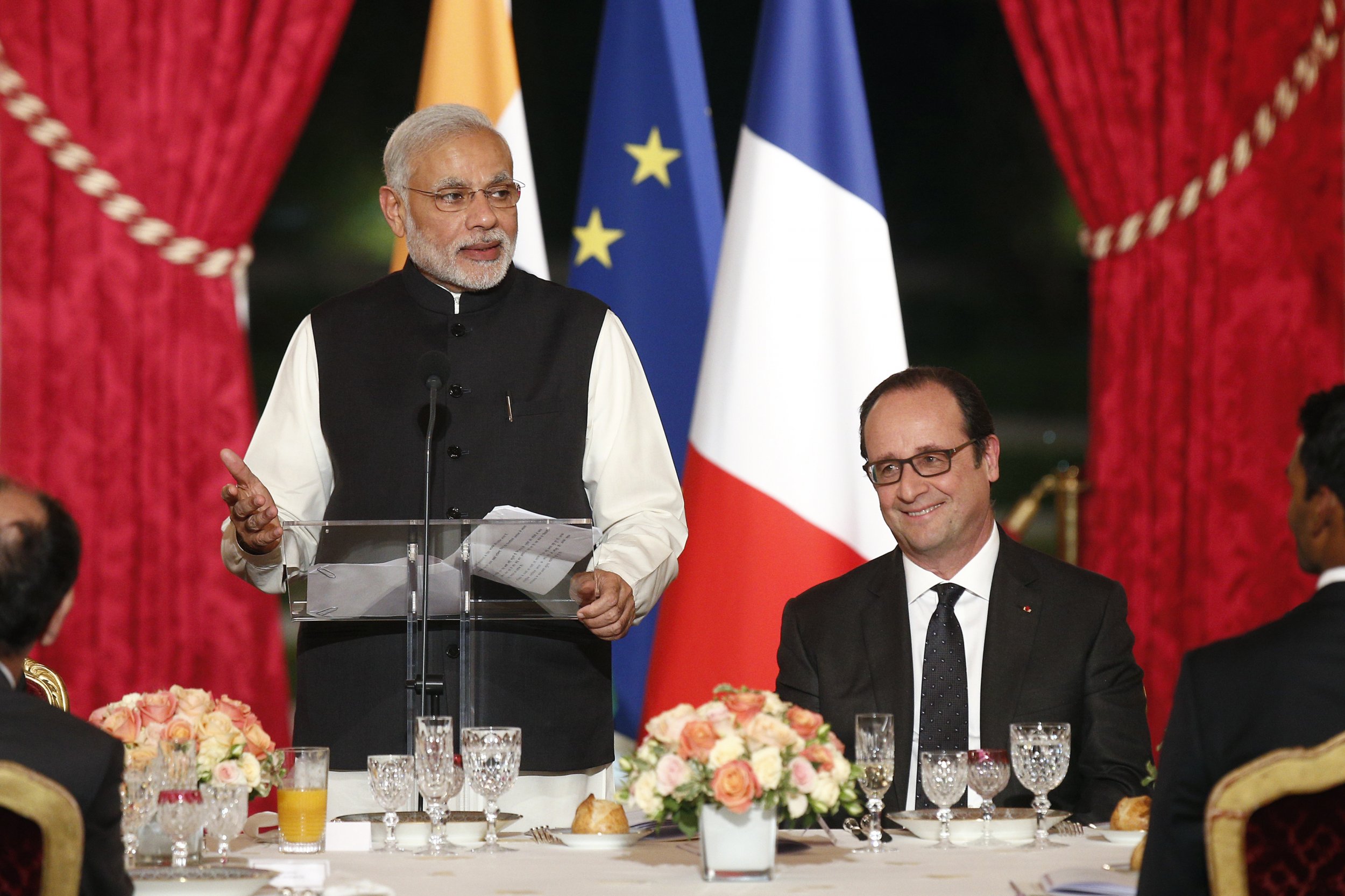
Prime Minister Narendra Modi has taken India's defense industry by surprise with a totally unexpected decision to buy 36 Rafale fighter jet aircraft, costing probably around $4.5 billion, from Dassault Aviation in a deal that is being negotiated directly between the Indian and French governments.
Modi is on an official visit to France. He said after holding talks with President François Hollande in Paris on a range of subjects that included nuclear energy cooperation and 2 billion euros ($2.12 billion) French investment into India, that he had asked for 36 Rafale multirole combat aircraft "in fly-away condition as quickly as possible."
This means that the planes will be completely made in France, which is a temporary blow for Modi's Make in India campaign that has been relying on defense orders for early successes that have yet to materialize.
The Indian Air Force (IAF), however, is seriously depleted of serviceable fighter jets, just as other branches of India's defense forces are deplorably underequipped. It has only 32 working squadrons compared with a requirement of about 40 and the total is expected to come down maybe to as low as 20—half what is needed—within three years when old Russian MiG and other aircraft are taken out of service.
That has led Modi to cut through the red tape of defense acquisition procedures to initiate a quick deal, even though three years of tortuous negotiations to buy 126 Rafales have failed to reach agreement. The first 18 of those planes would have been made in France instead of the new 36 (two squadrons) figure.
Negotiations will, it is understood, now continue separately for 108 aircraft to be made as originally planned in Bangalore at Hindustan Aeronautics (HAL), the Indian public sector's aircraft builder. The deal was originally priced at around $13 billion when the Rafale was selected by India in 2012, but the figure demanded by the French company has risen to from $18 billion to 20 billion and it is not now clear how urgently India will pursue these negotiations.
The proposed purchase of 36 "fly away" aircraft can be presented as an example of Modi's willingness to spring unconventional surprises when that is in the national interest—and clearly there is an urgent need to buy aircraft quickly if the IAF is to look a viable fighting force.
But it is also a coup for France and Dassault, which have played hardball since 2012 when India controversially picked the Rafale, after five years of tenders and evaluations, instead of the European EADS consortium's Eurofighter. Three other contenders—Boeing's F-18 and Lockheed's F-16 jets from the U.S., and Sweden's Saab Gripen—were eliminated earlier.
First, Dassault refused to accept HAL as the lead Indian production agency because of the government company's questionable delivery and quality reputation. Instead, it wanted the lead role to be played by Reliance Industries, run by Mukesh Ambani. Reliance has no engineering manufacturing experience but has soaring ambitions and strong finances, plus some political clout (especially with the last Congress government).
HAL successfully mobilized support within the defense establishment and sidelined Reliance, but Dassault then refused to bear responsibility for the quality and quantity of aircraft produced by HAL, and it also raised the price.
A.K. Antony, the Sonia Gandhi loyalist who was the nonperforming defense minister in the last government, could not cope with such pressures and ducked taking a decision, so the Modi government inherited tortuous negotiations that were stuck in bureaucratic rules and procedures, and an air force urgently needing aircraft.
The new defense minister, Manohar Parrikar, has been pushing for an order to be placed but Arun Jaitley, the finance minister, has been saying that there are not sufficient funds available for 126 aircraft. That led India's defense industry and most analysts to believe that the negotiations were going nowhere and that there would be no Rafale contract.
Instead, Modi took the decision to do the new government-to-government negotiated deal, which is the usual structure for defense contracts with Russia and is sometimes done with the U.S.
Earlier today it was widely reported that he would ask for 63 jets. It is not clear whether that was incorrect or whether the number came down during the talks.
The government can now try to push down the price of the aircraft because Dassault desperately needs work at its French factories for the Rafale, only 24 of which have been ordered by Egypt.
It will probably have to face renewed criticism that the Rafale is not the best choice for the IAF because of its high cost and its lack of other significant orders. The U.S., which was seriously annoyed when Boeing and Lockheed aircraft were dismissed, will probably argue for its aircraft to be reconsidered. Others will argue that the Saab Gripen would be a cheaper and more realistic alternative.
Many experts have been puzzled why India chose the Rafale in the first place. Today's developments do nothing to clear the air on that.
John Elliott's Implosion: India's Tryst With Reality is published by HarperCollins, India. He can be read at ridingtheelephant.wordpress.com
Uncommon Knowledge
Newsweek is committed to challenging conventional wisdom and finding connections in the search for common ground.
Newsweek is committed to challenging conventional wisdom and finding connections in the search for common ground.
About the writer
To read how Newsweek uses AI as a newsroom tool, Click here.








